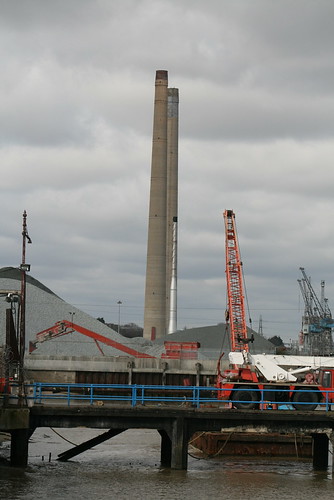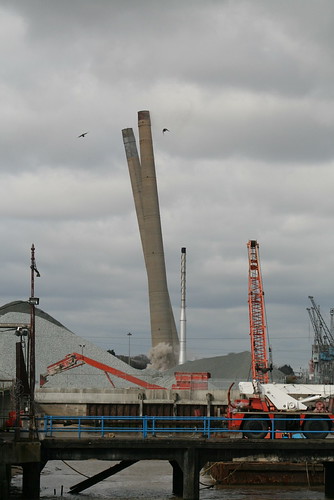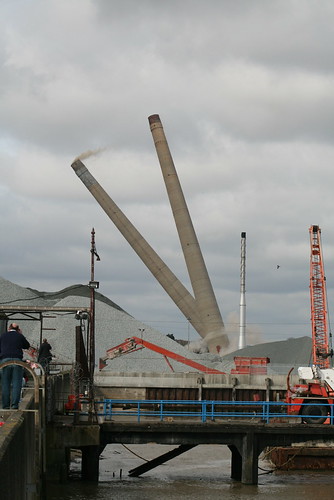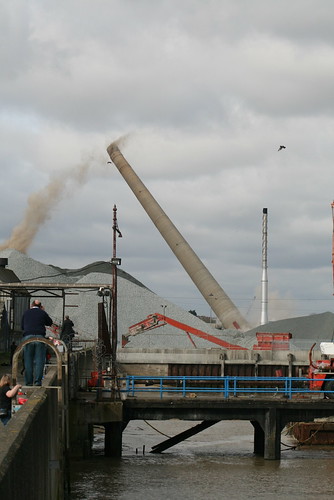
In just a few hours from now the skyline of Northfleet, Kent will be changed for ever when the two 550' tall chimneys at the former Blue Circle (Lafarge) cement works are demolished by controlled explosion.
The destruction of the two chimneys, which have towered over Northfleet on the banks of the River Thames for the last forty years, marks the end of (yet) another established local industry.
The history of cement manufacture in this part of Kent dates back to the late 1790's when a clergyman called James Parker patented "Roman Cement" and set up his factory in Northfleet.
"Roman Cement" was made from a dry mixture of chalk and clay, both available locally in great abundance, which were mixed together and burnt to form a mortar like material.
In 1825 James Frost patented "British Cement" which was also made from a mixture of chalk and clay but this time it was mixed together with water to form a slurry before being fired. Frost set up a cement works in Swanscombe - a few miles further up the Thames from Northfleet.
Around the same time that Frost patented his "British Cement", a businessman from Leeds called Joseph Aspdin patented "Portland Cement" - the forerunner of the cement we all know today. Aspdin had no background in chemistry and his product was developed purely through trial and error.
In 1841, Joseph Aspdin's son William left the family business under a cloud having got himself into debt, and moved to London.
William, who seems to have been a bit of a chancer, set up a factory in Rotherhithe, London making "Modern Portland Cement". Production was transferred to Northfleet in 1846 when he took over the works founded by James Parker.
The product was an improved version of the cement produced by his father's company but was never separately patented.
William used to imply that his product was covered by his father's patent and would go to extreme lengths to keep his formula a secret. It is said that he would emerge from his office when each kiln was ready for firing, and scatter in handfuls of brightly coloured crystals over the rawmix, in order to give the impression that the special properties of his product were the result of an unidentified "magic ingredient".
William Aspdin and money were not good bedfellows and he was declared bankrupt on several occasions. Often having to move on to remain one step ahead of his creditors, he finally emigrated to Hamburg, Germany where he founded the first Portland cement factories outside the UK.
By 1900, there were around fifty or sixty small cement manufacturing companies located all over the country competing with each other for market share. In that year twenty four companies merged together to form Associated Portland Cement Manufacturers Ltd (APCM).
In 1912, most of the remaining independent cement manufacturers merged to form The British Portland Cement Manufacturers Ltd (BPCM).
In 1920 the Cement Marketing Company was set up to control the sale of all cement produced by APCM and BPCM and the Blue Circle logo, which still exists today, was introduced.
By the 1960's, many of the smaller cement works were becoming uneconomic due to advances in technology. APCM commissioned a "new" Northfleet Works which came on stream in 1970 and was, at the time, one of the largest and most advanced cement factories in the world with annual production of over one million tonnes.
Apart from serving the UK market, clinker and finished cement was exported to many countries from the plant's own deep water jetty on the Thames.
 Northfleet Works in 1973 (picture by Pierre Terre)
Northfleet Works in 1973 (picture by Pierre Terre)Chalk was quarried at two enormous pits at nearby Bean, one of which now houses the Bluewater shopping complex. Clay slurry was pumped under the River Thames from Ockendon, Essex and coal for the kilns was delivered direct to the works by rail.
The factory originally had six rotary kilns - they are the very long steel tubes shown in the 1973 picture above - that rotated slowly and sloped down away from the river. A slurry of chalk and clay was pumped into the back end of the kiln which was heated to a very high temperature and turned into clinker, the base material for Portland cement.
The clinker was then passed through a series of grinding mills which were large rotating steel drums full of ball bearings that crushed the material into a fine powder. Gypsum was added to the ground clinker to make Portland cement.
In the early 1980’s two of the kilns were removed to make way for a press plant. The press plant was used to squeeze some of the moisture content from the chalk/clay slurry and turn it into a drier cake like material. This reduced the amount of energy required to heat the kiln and was therefore more efficient and cost effective. Two of the four remaining kilns used the cake instead of slurry. Shortly afterwards the remaining two slurry fed kilns were taken out of operation.
In 2001 Blue Circle was taken over by Lafarge of France and in 2008 the Northfleet Works was closed due to a shortage of chalk reserves at the Bean quarry. Lafarge are currently developing a new cement works on the River Medway near Snodland.
Demolition of the Northfleet Works commenced in 2009 as part of a major redevelopment plan which covers a large swathe of the Thames river front between Gravesend and Northfleet.
Here are some more pictures that I took of the demolition in progress....

Clinker and cement was shipped by Blue Cirlce to many countries from Northfleet Works.

Part of the conveyor system that fed coal into the kilns.

One of the rotary kilns can be seen to the left of the picture.

In this building coal was pulverised and then blown into the kilns using large fans.

Part of one of the rotary kilns can be seen to the left of this picture.
If you have enjoyed reading this post, please feel free to leave a comment. They are always welcome.
Other posts you may enjoy....
W T Henley / AEI Cable Works, Northfleet
Viscount Northcliffe - Pioneer Press Baron


































 In this building coal was pulverised and then blown into the kilns using large fans.
In this building coal was pulverised and then blown into the kilns using large fans. Part of one of the rotary kilns can be seen to the left of this picture.
Part of one of the rotary kilns can be seen to the left of this picture.



